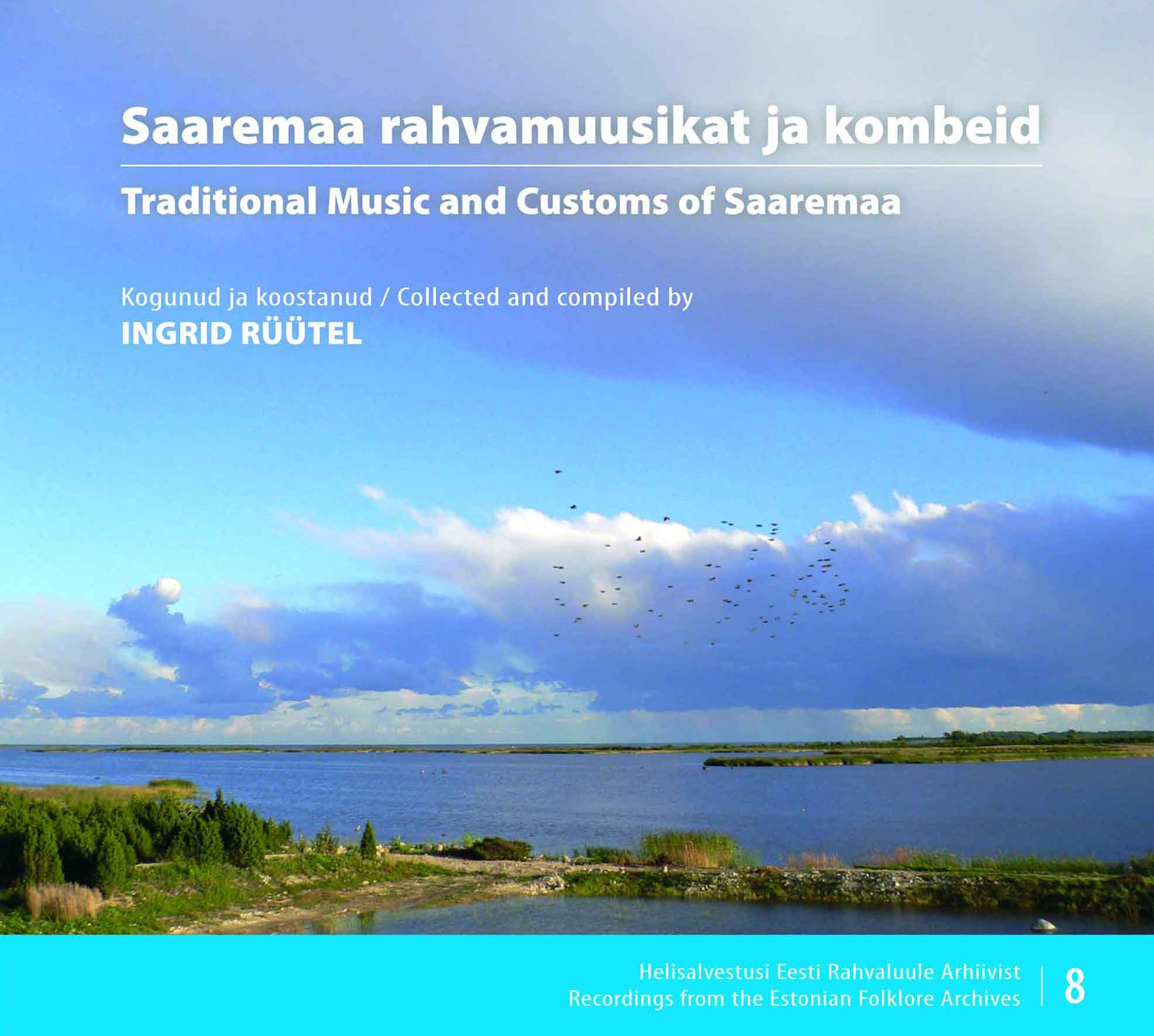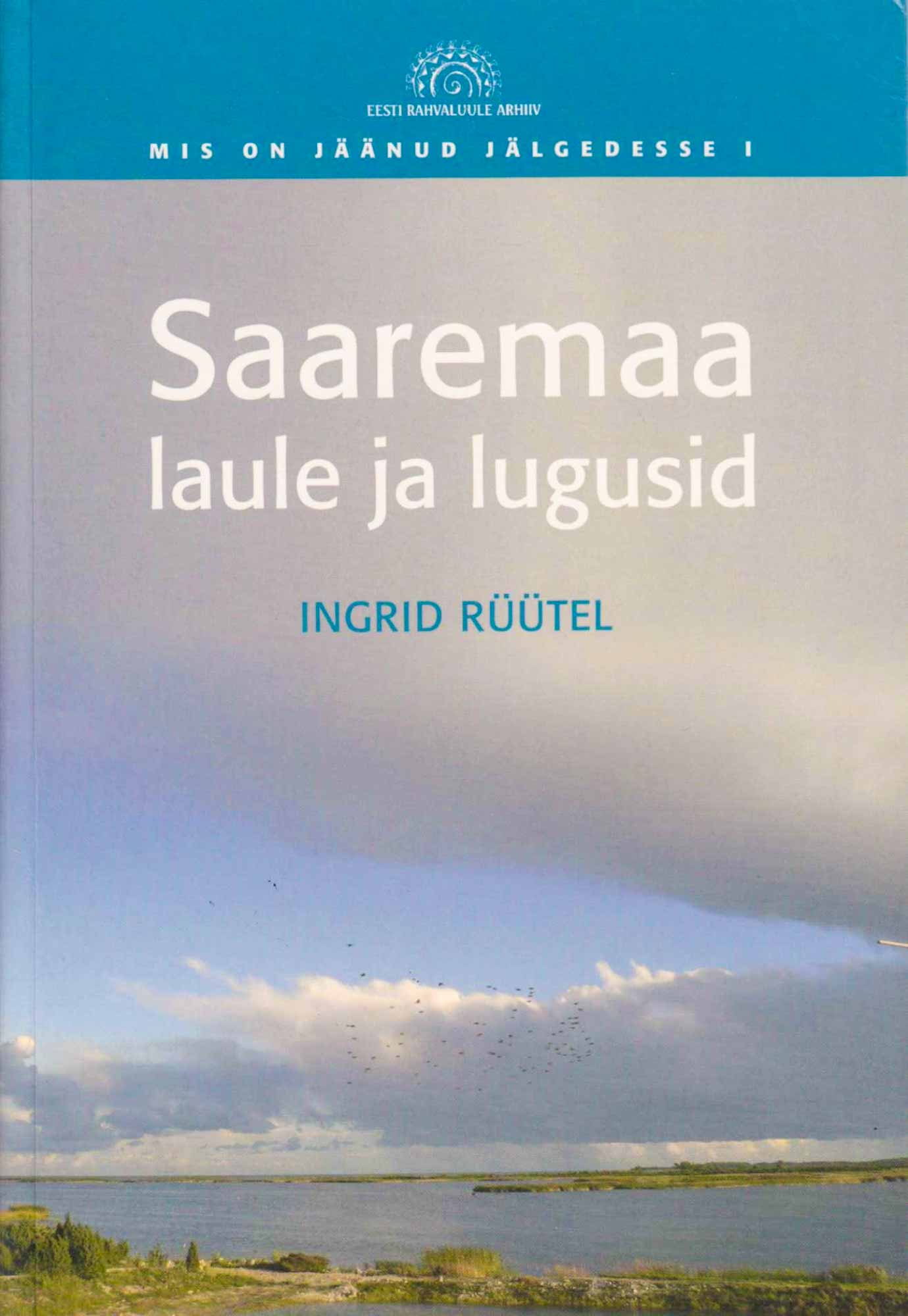Foreword
This publication, "Traditional Music and Customs of Saaremaa", contains a selection of Saaremaa songs, dances and examples of customs from the materials of the Estonian Folklore Archives of the Estonian Literary Museum. The material has been recorded by Ingrid Rüütel and her colleagues during 1961–2012. The sound recordings give an overview of the islanders' songlore in the early 20th century. The segments of film date back mostly to 1961, representing meetings with local songmakers, singers and instrumentalists, giving examples of social dances' local versions, New Year's customs and Mustjala wedding customs. The humorous village songs by Maidu Vallik were recorded with the help of a video camera in 2012.
This web publication is based on the publication of 2014 "Traditional Music and Customs of Saaremaa", which consists of a CD, a DVD and a text booklet.

"Traditional Music and Customs of Saaremaa", published in 2014, compiled by Ingrid Rüütel.
The lyrics and sheet music of the tunes on the CD and DVD (except Mustjala wedding songs) are published in the book "The Songs and Tales of Saaremaa", which gives a more thorough overview of the islanders' songlore of the early 20th century, portrays several singers in more detail, describes the circumstances of singing, etc.
The book’s electronic version is available here.

"The Songs and Tales of Saaremaa", the book compiled by Ingrid Rüütel, published in 2015.
The web publication combines the material of the set of disks and the book. The sound recordings published in the set are complemented by lyrics and sheet music published in the book (if there is no sheet music of a song in the book, the e-publication does not have it either). The web publication contains the extracts from the book introduction and Ottlie Kõiva and Ingrid Rüütel's field work diaries help create the portraits of the performers of songs and instrumental pieces, and the presenters of customs.
The 39 sound recordings of the publication were collected mostly by Ingrid Rüütel and Ottilie Kõiva in 1961 during the expedition of the Folklore Archives to eastern Saaremaa. Part of the recordings were made at Valjala in 1974 and at Torgu and Pihtla in 1975. The filming of Saaremaa songs, dances and customs was also done during the 1961 expedition. The video recordings of Maidu Vallik's songs were made by Ingrid Rüütel at Laimjala in 2012.
The overview part of the publication contains introduction and description of sound and videorecordings by Ingrid Rüütel from the 2014 publication "Traditional Music and Customs of Saaremaa", followed by the introduction of the performers presented in the publication. The performers can be found by name (in alphabetic order) and by names of the villages. Some performers may be found under several villages because their place of residence and birthplace were not same. The page of each performer contains his or her photograph and extracts, introducing him or her, taken from the book "The Songs and Tales of Saaremaa". Then comes the list of recorded pieces or the title of the movie with the person's performance. At the end of the page, there is information about the performer's age at the time of the recording and his or her place of residence, followed by name of the collector and the year of collection.
The order of songs and movies corresponds to that of the 2014 set of disks. Songs can also be browsed in alphabetical order either according to their first lines or titles. The page of each song contains the name of the performer and his or her place of residence with the year the recording was made, the recording itself, sheet music and lyrics, and occasionally some comments from the performer. There are also short summaries of the content of the songs. At the end of the site, there is more detailed information about the performer, recording data and the reference to the original recording in the Estonian Folklore Archives. At the end of the source reference, the serial number of the piece in square brackets indicates its location in the book "The Songs and Tales of Saaremaa".
Each movie page contains names and places of residence of those, who appear in the movie (if known) and the year the recording was made. In addition to the entire movie, some movies offer opportunity to watch clips about certain instrumentalists and singers or songs, instrumental pieces and dances. A short summary of the content of the movie and also extracts from Ottilie Kõiva and Ingrid Rüütel's expedition diaries, concerning the filming, complement the pages. At the end, one can find the reference to the location of the original recording in the Estonian Folklore Archives. In the movie about Maidu Vallik, each song can also be found on a separate page with sheet music and lyrics.
In the dialectal lyrics, the initial h-s of the words are marked in accordance with the tradition of the written language, although in Saaremaa the h is generally not pronounced in the beginning of the word. The overlong öö is pronounced by Saaremaa singers mostly as a sound that is sort of between ö and ü, but in the lyrics of the web version, these are still written as öö. The same applies to the overlong ee, which is pronounced as a sound between e and i. In the sheet music, the details of the performance are shown with the help of additional signs.
We are grateful to all our good helpers and supporters; also the one-time employees of the Folklore Archives, who took part in the recording of the material of this publication. The creation of this web publication represents the wish of the ensemble Trad.Attack! to support the Estonian Folklore Archives. The support of renowned performers of traditional music, as well as their music, which gives new life to archival recordings, makes the commitment and work of all those, who know and collect traditional material, as well as the keepers and mediators of these collections, more valuable.
Our greatest thanks goes to Saaremaa singers, instrumentalists and connoisseurs of old traditions, who have generously shared with us their knowledge of the peculiar and rich culture of Saaremaa.
22.02.2018
Ingrid Rüütel
Janika Oras
Kadi Sarv
Publication
Introduction to publication
Performers
Performers by village
Asva village (Pöide)
Audla village (Pöide)
Haeska village (Valjala)
Kalma village (Pöide)
Kiriku village (Valjala)
Kungla village (Valjala)
Kõiguste village (Pöide)
Kõnnu village (Valjala)
Liiva-Putla village (Püha)
Loona village (Püha)
Mässa village (Jämaja)
Orinõmme village (Pöide)
Oti settlement (Pöide)
Pahavalla village (Pöide)
Ridala village (Pöide)
Soonda village (Muhu)
Sõrve
Turja village (Valjala)
Tõnija village (Valjala)
Veere village (Pöide)
Võhma village (Pöide)
Sound recordings
Headings of the songs Aa-Zz
- 1. Shipwreck
- 2. Once upon a time there lived a man (David and Goliath)
- 3. The tailors' party
- 4. Skylark
- 5. Timmu-tammu
- 6. Back in the year of 1906
- 7. The Germans have been looking for a fight for quite a while
- 8. 'Twas a lad from around the Haeska manor
- 9. It's gonna turn pretty noisy around here
- 10. Kuressaare recreational park and seashore
- 11. Our fathers and mothers are islanders
- 12. Our Saaremaa
- 13. Little sister-islands
- 14. In a castle atop the mountain (circle game with insert dance songs)
- 15. The road through Sääre village
- 16. Our Saaremaa
- 17. Passing by the Pöide church
- 18. And the twenty one (circle game)
- 19. Alone amongst strangers
- 20. Mother took the cradle to the meadow
- 21. Birds upon the treetops
- 22. I'll take a young wife
- 23. Horn tune
- 24. Girl, your gaze strikes right through the heart (soldiers' song)
- 25a. The big mighty ship (insert dance song of a circle game)
- 25b. I sat on the threshold (insert dance song of a circle game)
- 25c. War, oh war (insert dance song of a circle game)
- 25d. I saw a flower in the valley (insert dance song of a circle game)
- 25e. Flowers blooming in the meadow (insert dance song of a circle game)
- 25f. Estonian boy (insert dance song of a circle game)
- 26. Girlie girl (circle game with insert dance songs)
- 27. High atop the mast
- 28. On the battlefield in the far away land
- 29. Soon comes the time
- 30. On the wide expanse of the Atlantic
- 31. Coming to Toila (song of a deep-sea sounding team)
- 32. In February, when the weather's harsh (seal hunter's song)
- 33. Whoever sailed the sea
- 34. Tip of Sõrve is a nest of songs
- Aasa peal õitsevad (ringmängu vahelaul)
- Atlandi ookeani laial pinnal
- Ema viis hälli heinamaale
- Ennemuiste oli üks mees (Taavet ja Koljat)
- Juba väljal puude otsas
- Kaugel üksi võõra rahva hulgas
- Kes purjetand on laevaga
- Kui aastanumber sai 1906
- Kui läed mööda Pöide kergust
- Kui rätsepate aastapäev
- Kui Toila tulin (loodipoiste laul)
- Kuressaare huvielu park ja mereäär
- Kõrgel masti tipus
- Küll te kuulete siin müra
- Küünlakuus, kui ilm on käre (hülgeküti laul)
- Laevahukk
- Liiri-lööri löuke
- Meie isad ja emad on saarlased
- Mina istsin ukseläve pääl (ringmängu vahelaul)
- Mina nägin orus lille (ringmängu vahelaul)
- Mäe otsas kaljulossis (ringmäng vahelauludega)
- Neiu, sinu silmavaade (sõdurilaul)
- Neiukene noorukene (ringmäng vahelauludega)
- Oh eesti poiss (ringmängu vahelaul)
- Oh sõda, sõda (ringmängu vahelaul)
- Oh te väiksed sõsarsaared
- Pea jõuab aeg
- Sakslane küll tahtis ammu
- Sarvelugu
- Seal võõrsil valuväljal
- See kakskümmend üks (ringmäng)
- See oli üks Haeska mõisa ligidalt poiss
- See Saaremaa
- See Saaremaa
- See suure uhke laevaga (ringmängu vahelaul)
- Sörve ots on laulupesa
- Tee Säärekülast läbi käib
- Timmu-tammu
- Võtan aga naise noorukese